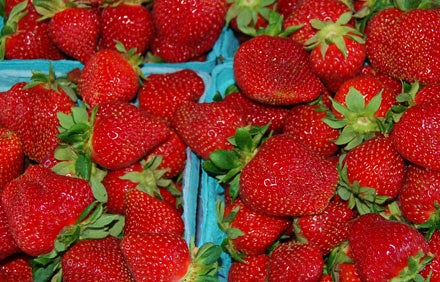Celebrate strawberry season in style
Published 12:02 pm Thursday, April 15, 2021

- (Photo from file)
|
Getting your Trinity Audio player ready...
|
The best strawberries are the ones you pick yourself or buy from your local strawberry farm. These berries will be the freshest you can get, with little or no handling and travel. Nothing beats the flavor and fragrance of fresh-picked strawberries. When you pick your own be sure and pick by pinching the stem of the berry between your thumb and forefinger. This will prevent damage to both the fruit and the strawberry plant. Leaving the caps on helps your strawberries last longer. Also watch for locally-grown strawberries in your neighborhood supermarket during the harvest season.
When shopping for strawberries, select those that are firm, plump, and fragrant and have a bright glossy red appearance. Their fringed caps should be bright green and look fresh. Look for structural integrity. Berries should be firm, but not crunchy. Avoid bruised or shriveled berries or those having a dull appearance.
Strawberries do not ripen after they are harvested. Select fruit that’s at the right state of maturity — when the berry surface is fully red. This fruit will offer the maximum sweetness and flavor.
Strawberries are best when prepared and eaten on the same day, but if you must keep them longer, store them in your refrigerator. Arrange the berries in a shallow container, separating out any damaged berries. Cover them loosely, and keep at 35 degrees Fahrenheit for best results. Store the fruit in the crisper drawer of the refrigerator. Strawberries packaged in closed plastic clamshell containers may be stored in their containers or fruit may be stored in a partially opened plastic bag to maintain high humidity. Strawberries can only be stored for up to seven days under optimum conditions. Keep in mind that shelf-life depends on how ripe the fruit was when purchased or picked. Do not remove the caps or wash the berries until you are ready to use them. When caps are removed before use, the berries lose some of their moisture. Washing early tends to bruise them and the berries lose their freshness.
Strawberry flavor is at its best at room temperature. Remove the berries from the refrigerator an hour or two before serving. To help berries retain flavor, texture and nutrients, avoid washing or removing their caps until ready for use.
When preparing (for whatever use), place the berries in a strainer and rinse with cool water. Never let them sit in water. To remove the caps, give the caps a gentle twist or use the point of a sharp knife, trying not to remove any of the berry. The tip of an ordinary vegetable peeler makes a good tool for capping berries.
Here are a few helpful tips to follow when you pick your own strawberries: dress comfortably, wear loose fitting clothing and a hat or cap and bring sunscreen and your own containers.
If you plan to spend the day or are not going straight home, take ice in a cooler to keep berries cool. Select only firm ripe berries. Be careful not to remove the tops of the berries. Make an effort to pick every ripe berry on each plant rather than jumping from plant to plant and row to row. The growers will appreciate your consideration and you will reduce the amount of strawberries that are left sitting in the field.
How many are enough? Here are some quick measurement to help you know the yield of strawberries:
- 1 pint basket of berries = 2½ cups whole berries
- 1 pint basket of berries = 2¼ cups sliced berries
- 1 pint basket of berries = 1¾ cups pureed berries
- 1 pint basket of berries = about 12-14 large berries or 16-20 medium berries
- 1 quart of berries weighs about 1¼-1½ pounds
- 1 flat of berries (8 quarts) weight varies from 10-12 pounds depending on the size of the fruit
- 1½ to 2 quarts are needed for a 9″ pie
- 1 cup sliced fresh strawberries = one 10 oz. package of frozen strawberries
- 1 cup of strawberries contains approx. 50 calories.
You have several options for freezing strawberries.
- Whole berries: Place one layer of clean, capped berries on a cookie sheet and freeze until firm. Remove from the cookie sheet, package in freezer bags, and seal.
- Packing with sugar: Slice berries in halves or thirds. Mix with sugar (six cups sliced fruit to one cup sugar). Allow to stand until sugar dissolves (about 10-15 minutes). Pack the fruit and juice into freezer bags or containers. Leave 1/4-inch head space for pint containers.
- Packing without sugar: Strawberries may also be packed whole or sliced without sugar or with minimal sugar, but the color and texture of the thawed fruit won’t be as good.
Select fresh strawberries not only for their delicious taste but for the nutritional benefits they offer you and your family. Think about it, just eight medium strawberries contain more vitamin C than one orange. Vitamin C helps your body heal, resist infections, and maintain healthy bones, gums, and teeth.
Strawberries are a significant source of fiber in the diet. They are also a good source of potassium and manganese. Strawberries are also rich in antioxidant compounds such as anthocyanin, quercetin, resveratrol, and ellagic acid. Studies indicate that these compounds found in strawberries may help reduce the risk of heart disease, cancer, hypertension, and Parkinson’s disease and reduce some of the cognitive declines of aging. There is also evidence that strawberries have properties that may assist with weight loss and with diabetes control. Like other richly colored berries, they are truly a super fruit.
One serving of fresh strawberries (one cup or about 6-9 berries) contains only 50 calories. Note: Frozen strawberries retain all the nutritional benefits of fresh strawberries. Strawberries are virtually fat free, contain no cholesterol and are an excellent source of folic acid that helps the body metabolize protein. You can eat them out-of-hand, on the run. Just wash and bite — anytime, anyplace.
Some fun strawberry facts:
- Eating eight strawberries a day has been shown to lower blood pressure and to improve memory and heart health. Not only that, eating strawberries on a regular basis may lower the risk of some cancers and help reduce obesity.
- Strawberries provide essential nutrients and minerals including fiber, potassium, vitamin C and powerful antioxidants such as anthocyanins, quercetin and ellagic acid.
- The levels of ellagic acid found in strawberries are five to six times higher than in most other fruits and vegetables. Some research shows that ellagic acid seems to have some anti-cancer properties.
- Wash. Bite. How easy is that? When you’re on the go, take strawberries with you in a plastic container or sandwich bag. You don’t even need to keep them cool. Strawberries taste best at room temperature.
- Strawberries must be picked at full ripeness. They cannot ripen once picked.
- Strawberry Shortcake originated with the American Colonists. It’s still a favorite today.
- Strawberries are the favorite fruit of Americans — both children and adults.
- Strawberries are the only fruit that have seeds on the outside — about 200 of them. Each seed has the potential to become a new variety. Strawberry seeds are all those little bumpy spots on the surface of the berry.
- Strawberry is the second most popular natural flavor. Chocolate is number one. Chocolate-dipped strawberries anyone?
- For a fast and delicious snack, spread graham crackers with a thin layer of cream cheese. Top with sliced strawberries to add some crunch. If calories are an issue, select low-fat graham crackers and low-fat cream cheese.
Strawberry Blueberry Freezer Jam
This recipe perserves your berries by freezing them and makes about six half-pint jars. This recipe is excerpted from The All New Ball Book of Canning and Preserving, published by Oxmoor House (2016).
Ingredients:
4 cups fresh blueberries, 4 cups halved fresh strawberries, 1-1/2 cups sugar, 5 Tbsp. Ball® Real- Fruit Instant Pectin, 6 Ball® plastic half-pint freezer jars
Directions:
- Pulse blueberries in a food processor until finely chopped, stopping to scrape down sides as needed. Place in a medium bowl.
- Pulse strawberries in food processor until finely chopped, stopping to scrape down sides as needed.
- Add to blueberries in bowl.
- Stir in sugar; let stand 15 minutes.
- Gradually stir in pectin; stir 3 minutes.
- Let stand 5 minutes.
- Spoon into jars, leaving 1⁄2-inch headspace.
- Center lid on jars. Apply bands, and adjust loosely.
- Once jam is frozen, adjust bands to fingertip-tight.
- Store in freezer up to 1 year. Thaw in refrigerator. Refrigerate after thawing, and use within 3 weeks.
For more strawberry recipes, register and attend a class entitled, “All Things Strawberry…” The class will be held at the Beaufort County Extension Center on Thursday, April 29 from 10 a.m. to 12 p.m. and 6 p.m. to 8 p.m. The space is limited as we will socially distance. To register, come to the Beaufort County Extension Center and select your time when you register. The fee is $10 per person . Spaces are filled on a first come first serve basis.
Sources for this article NC Extension Food and Nutrition, National Center for Home Food Preservation. For more information about the Foods and Nutrition please contact Louise L. Hinsley, Extension Agent, Family Consumer Science at the Beaufort County Center of NC Cooperative Extension, 155 Airport Road, Washington, 252-946-0111.





